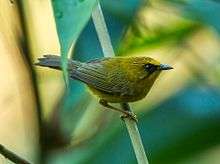Golden babbler
The golden babbler (Stachyridopsis chrysaea) is a babbler species in the family Timaliidae. It occurs from the foothills of the Eastern Himalayas to Southeast Asia and inhabits subtropical lowland and montane forests. It is listed as Least Concern on the IUCN Red List because of its wide distribution.[1]
| Golden babbler | |
|---|---|
 | |
| near Tingtibi, Bhutan. | |
| Scientific classification | |
| Kingdom: | Animalia |
| Phylum: | Chordata |
| Class: | Aves |
| Order: | Passeriformes |
| Family: | Timaliidae |
| Genus: | Stachyridopsis |
| Species: | S. chrysaea |
| Binomial name | |
| Stachyridopsis chrysaea (Blyth, 1844) | |
It has olive-green wings and yellow underparts. Its crown and nape are golden-yellow with narrow stripes. It is 19–12 cm (7.5–4.7 in) long and weighs 6–10 g (0.21–0.35 oz).[2]
Stachyris chrysaea was the scientific name proposed by Edward Blyth in 1844 who described an olivaceous babbler with a yellow crown from Nepal.[3] Since 2016, it is recognised as a Stachyridopsis species.[4][2]
References
- BirdLife International (2016). "Cyanoderma chrysaeum". The IUCN Red List of Threatened Species. IUCN. 2016: e.T22716193A94484067. doi:10.2305/IUCN.UK.2016-3.RLTS.T22716193A94484067.en.
- Collar, N. J.; Robson, C. (2016). "Golden Babbler (Cyanoderma chrysaeum)". In del Hoyo, J.; Elliott, A.; Sargatal, J.; Christie, D. A.; de Juana, E. (eds.). Handbook of the Birds of the World. 2: Passerines. Barcelona: Lynx Edicions.
- Blyth, E. (1844). "Appendix for Mr. Blyth's report for December Meeting 1842". The Journal of the Asiatic Society of Bengal. 13 (149): 361–395.
- Moyle, R. G.; Andersen, M. J.; Oliveros, C. H.; Steinheimer, F. D.; Reddy, S. (2012). "Phylogeny and Biogeography of the Core Babblers (Aves: Timaliidae)". Systematic Biology. 61 (4): 631–651. doi:10.1093/sysbio/sys027. PMID 22328569.
This article is issued from Wikipedia. The text is licensed under Creative Commons - Attribution - Sharealike. Additional terms may apply for the media files.
